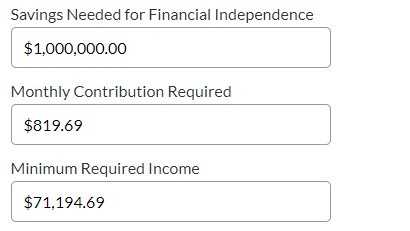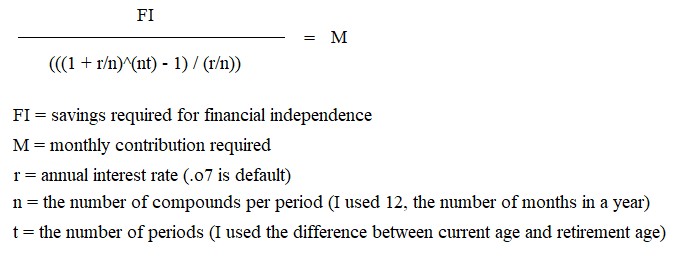This post may contain affiliate links. Please read our disclosure for more information.
This post was last modified on 8/16/2019 because Steverark pointed out a glaring deficiency in my MRI-RI Calculator that couldn’t be ignored. I neglected to account for inflation. Someone who is spending $40,000 annually today will be spending a lot more than that 20 or 30 years hence. Over the next couple of days, I hope to make my MRI-RI Calculator a little more inflation friendly. Bear with me.
How much savings you need to be financially independent is dependent on your annual expenses. A person who spends $100,000 annually will need a lot more savings to be financially independent than a person who spends $25,000 annually.
How much income you need to achieve financial independence is dependent on four variables—your annual expenses, your age, your savings to date, and your income.
So to keep my restless mind busy, I decided to devise a calculator that will show you if your income is large enough to achieve financial independence in your desired time frame. I’ve dubbed my calculator, the MRI-FI Calculator—the Minimum Required Income for Financial Independence Calculator.
MRI-FI Assumptions
Here are the assumptions I made for my MRI-FI Calculator.
- Financial independence is achieved when you have 25 times your annual expenses in savings.
- The default annual return on the savings in your portfolio is seven percent. You can change this if you prefer a more optimistic or pessimistic return.
- The default retirement age is 60. Again, you can change this if you prefer a different retirement age.
- All savings and investment contributions are made with after-tax dollars.
- The default takehome pay is 70 percent. In other words, I assume that 30 percent of your income will be whisked away by payroll taxes, state taxes, and federal taxes. You can change this if your takehome pay is a smaller or larger percentage of your gross pay.
- Finally, long-term inflation is pegged at 2.5 percent. Again, you can change this accordingly if you have a more optimistic or pessimistic view of how inflation will play out over the next several years or decades.
Okay, groovy freedomist, those are the assumptions that shaped the design of my MRI-FI Calculator. And now, without further ado, here is my vaunted MRI-FI Calculator.
How To Use the MRI-FI Calculator
The two things you absolutely must have in order to use the MRI-FI Calculator are your age and annual expenses. You can use the default settings for the other five input variables (current savings, retirement age, expected return, takehome pay percentage, and inflation rate).
Knowing your age is easy. Knowing your annual expenses isn’t, especially if you don’t bother to track your spending. To get the most out of this calculator, then, you need to track your spending. Does this mean you can’t use this calculator until you’ve accumulated 12 months of expense tracking? No. You won’t have a definitive understanding of your annual spending until you’ve tracked expenses for 12 months. But you can still formulate a crude estimate with as little as one month of expense tracking.
In order to do this, I want you to fudge your expense tracking results upward if you have fewer than seven months of tracked expenses. The reason for this is simple. The fewer months you have, the less likely your spending can be extrapolated accurately for the whole year. This is so because it’s easy to forget expenses that are paid annually or semi-annually (i.e., car insurance, life insurance, property taxes, etc.). And since it’s better to err on the side of caution—you don’t want to underestimate your spending and give yourself false hope—I want you to use the following fudge factors on your limited spending data.
- If you have one month of expenses, times that amount by 1.25, and then times that result by 12.
- If you have three months of expenses, times the total spending by 1.2, and then times that result by 4.
- If you have six months of expenses, times the total spending by 1.1, and then times that result by 2.
- If you have seven or more months of expenses, divide your total spending by the corresponding number of months that have been tracked.
| Number of Months with Expense Data | Accumulated Spending | Fudge Factor | Accumulated Spending Times Fudge Factor | Year Extrapolation Factor | Estimated Annual Spending |
|---|---|---|---|---|---|
| 1 | $3,000 | 1.25 | $3,750 | 12 | $45,000 |
| 3 | $9,600 | 1.2 | $11,520 | 4 | $46,080 |
| 6 | $17,400 | 1.1 | $19,140 | 2 | $38,280 |
MRI-FI Calculator Sample
Okay, let’s suppose that you estimate your annual expenses to be $40,000. And let’s further suppose that you’re 25 years old, don’t have any retirement savings, and want to retire at 55.

You plug those numbers into the top half of the MRI-RI Calculator and then click the Get Results button. Here are your results.

In order to be financially independent, you’ll need to accumulate a million dollars in savings. In order to accumulate that million dollars by the time you’re 55, you’ll need to open a brokerage account and invest $819.69 a month in at least one low-cost index fund (i.e., VTSAX, Vanguard’s total stock market index fund). And in order to invest $819.69 a month, you’ll need to make at least $71,194.69 annually.
$40,000 (Annual Expenses) + $9,836.28 (Annual Investments) = 70 Percent of $71,194.69
Now let’s look at some scenarios.
1. You don’t make $71,194.69.
If you don’t make $71,194.69, you have three options. The first option is to increase your desired retirement age. You may not make enough to retire at 55, but you may make enough to retire at 60 or 62. The second option is to focus on your annual expenses. If you reduce your annual expenses to $35,000, your monthly contribution requirement would drop to $717.23 and your minimum required income would drop to $62,295.37. The third and final option is to focus on your income. Start increasing your job skills and make yourself more valuable in the labor market. And until your skills can command the minimum required income for financial independence, there’s always the venerable side hustle.
2. You make $71,194.69 but aren’t saving $819.69 a month.
Something’s off. Either you’re spending more than you realize or your takehome pay is less than 70 percent of your gross pay. Review your spending and review your pay stub.
3. You’re making more than $71,194.69 and saving $819.69 a month or more.
Keep doing what you’re doing. You’re doing great.
Limitations of My MRI-FI Calculator
My MRI-FI Calculator is a simple tool. Its primary purpose is to see if financial independence is feasible given your income and your desired retirement date. As such, it has a few flaws you should be aware of. Here they are.
1. It doesn’t account for pretax monthly contributions.
My MRI-FI Calculator assumes that you’re using after-tax money for your monthly contributions—you’re making your investments in a Roth IRA or a standard brokerage account. But what if you’re using pretax money—you’re making investments in a traditional IRA or a 401(k)? If that’s the case, the minimum required income will be less than what my MRI-FI Calculator indicates.
2. It doesn’t address investment strategies or asset allocation.
My MRI-FI Calculator assumes your monthly contributions aren’t being placed in a savings account. It assumes that your monthly contributions are being used to buy shares in quality mutual funds. It also assumes that you know what you’re doing—that you understand risk, understand the importance of mitigating management fees, and understand how to allocate assets between stocks and bonds and generate a decent return over several decades (7 to 10 percent annually).
3. I think I used the right formula.
To calculate the monthly contribution required for FI, I used the following formula based on a future value formula from this website.

Does the blogger who provided the future value formula know his sh*t? Is this the correct formula to use for my MRI-FI Calculator, and have I tweaked it properly? I think I’ve created a worthwhile tool, but I really don’t know for sure. Perhaps a finance nerd will check my formula and let me know if I screwed up.
Final Thoughts
Okay, groovy freedomist, that’s all I got. What say you? Is my MRI-FI Calculator a worthy contribution to the FI community and a handy tool for any FI enthusiast? Or is it just another ho-hum tool that will be widely ignored and little remembered? Let me know what you think when you get a chance. Peace.
Mrs. Groovy here. I’m here to tell you my beloved husband is not the only creative one in this dynamic duo. Behold the unveiling of my barn quilt just mounted above our garage door. It depicts the North Carolina Star.



Being a radiologist I earn quite a bit of my living from MRIs.
I like your MRI as well, very cool concept.
xrayvsn recently posted…How to Spend Every Last Dollar or Leave it all to Charity
LOL! Made my day, Xrayvsn. Thank you.
Always like your stuff, Mr. Groovy! Gets my mind thinking . . .
I think I could make a strong argument about why you should shoot for the moon instead of just skating by, by reaching a calculated goal. I’d much rather put a lot of eggs into trying to create a high passive income (by buying businesses, stocks, real estate, other cash producing assets) than to work the 9-5 until I’ve saved up enough to likely be able to retire on the 4% rule. Much higher chance of crashing and burning, but it’s probably worth it to get out of the work force and do something you actually enjoy doing. If you succeed, you’ll likely have more income than you can spend! Exciting!
Nevertheless, great calculator!
Excellent point, DP. My brother went the entrepreneurial route and I went the W-2 route. He worked harder, but earned more and was happier. If I had to do it all over again, I definitely would have tried the entrepreneurial route. It would have been riskier, but there’s no glory without risk. Great comment.
Hi Mrs G,
The quilt looks amazing.
But how are you protecting it from the elements? Rain and Sun will take their toll. (Rain is more of a problem to us in Edinburgh, Scotland, than the sun, but you live in a far more pleasant environment, so the sun is your bigger problem!)
Are you going to make a new one each year??
Thanks Erith!
We put 3 coats of polyurethane over it. We plan to take it down once a year and do another coat of poly if needed. Time will tell — this is all new to me!
Mrs. Groovy recently posted…Minimum Required Income for Financial Independence
I had to google ‘barn quilt’; never heard of them before.
Looks good!
Same here. Until we moved down south, we never heard of barn quilts either. They bring a lot of charm to farm country.
It looks valid to me, but for the 25 year old looking to retire at 55 who spends $40,000 annually now in 2019 it’s unlikely $40,000 is what he will need in 2049, his first year of retirement. $40,000 in 2049 will only have the purchase power of $19,000 today. So his total savings will have to be $2.1 million to support his current lifestyle. The 4% rule handles inflation for every year but the year you retire. You have to manually adjust the target for that year. For a fast FIRE path of 5 years or less you can pretty much ignore inflation but not for a thirty year plan.
Steveark recently posted…You Might Have Dialed the Wrong Number
Awesome point, Steveark. Thank you. I’m in the process of modifying my MRI-RI Calculator to account for inflation. Should have it done in a day or two. Stay tuned.
This is awesome! Great job, Mr. G! And kudos to Mrs. G. on the quilt – it looks amazing!
Thank you, LB.